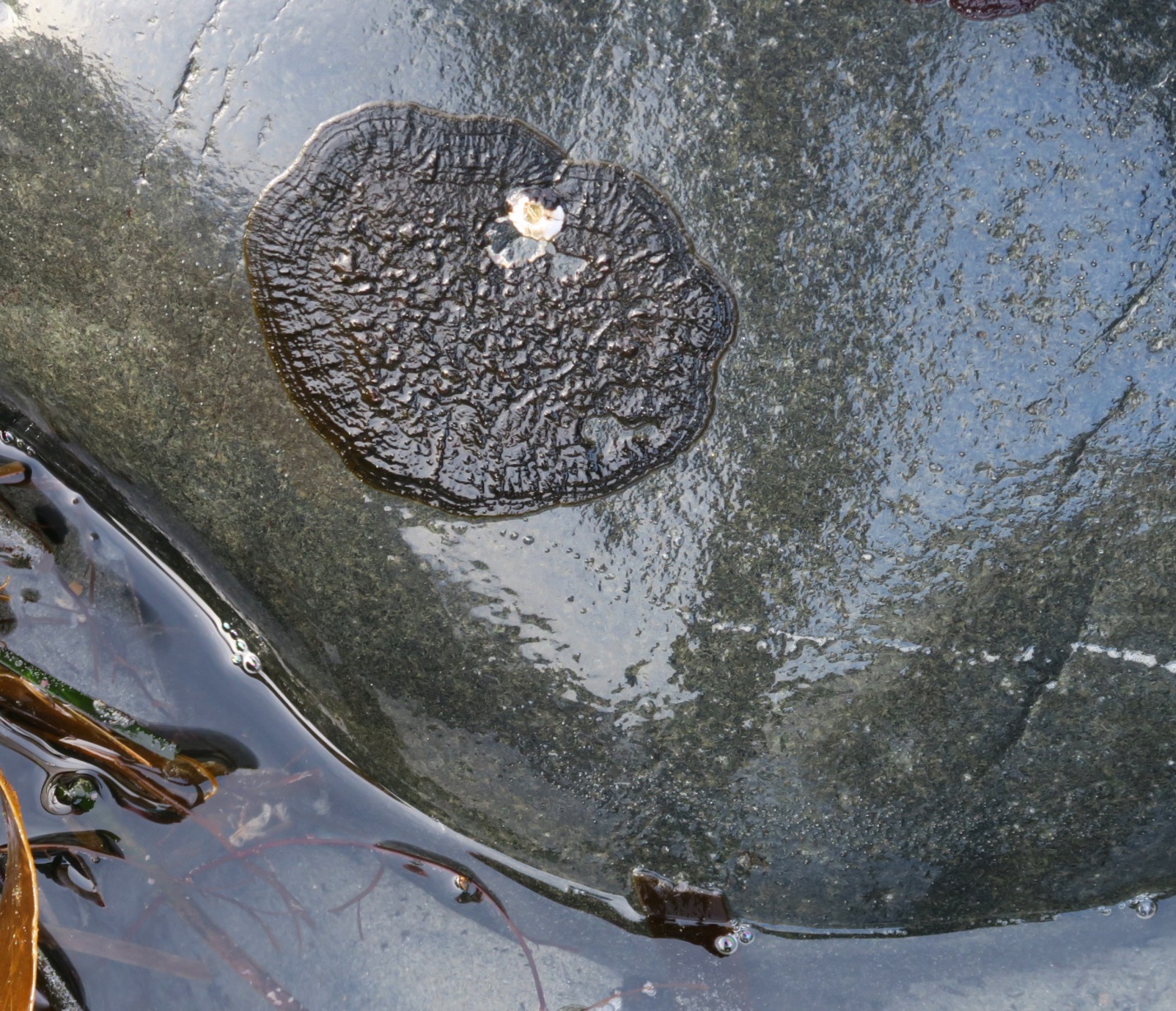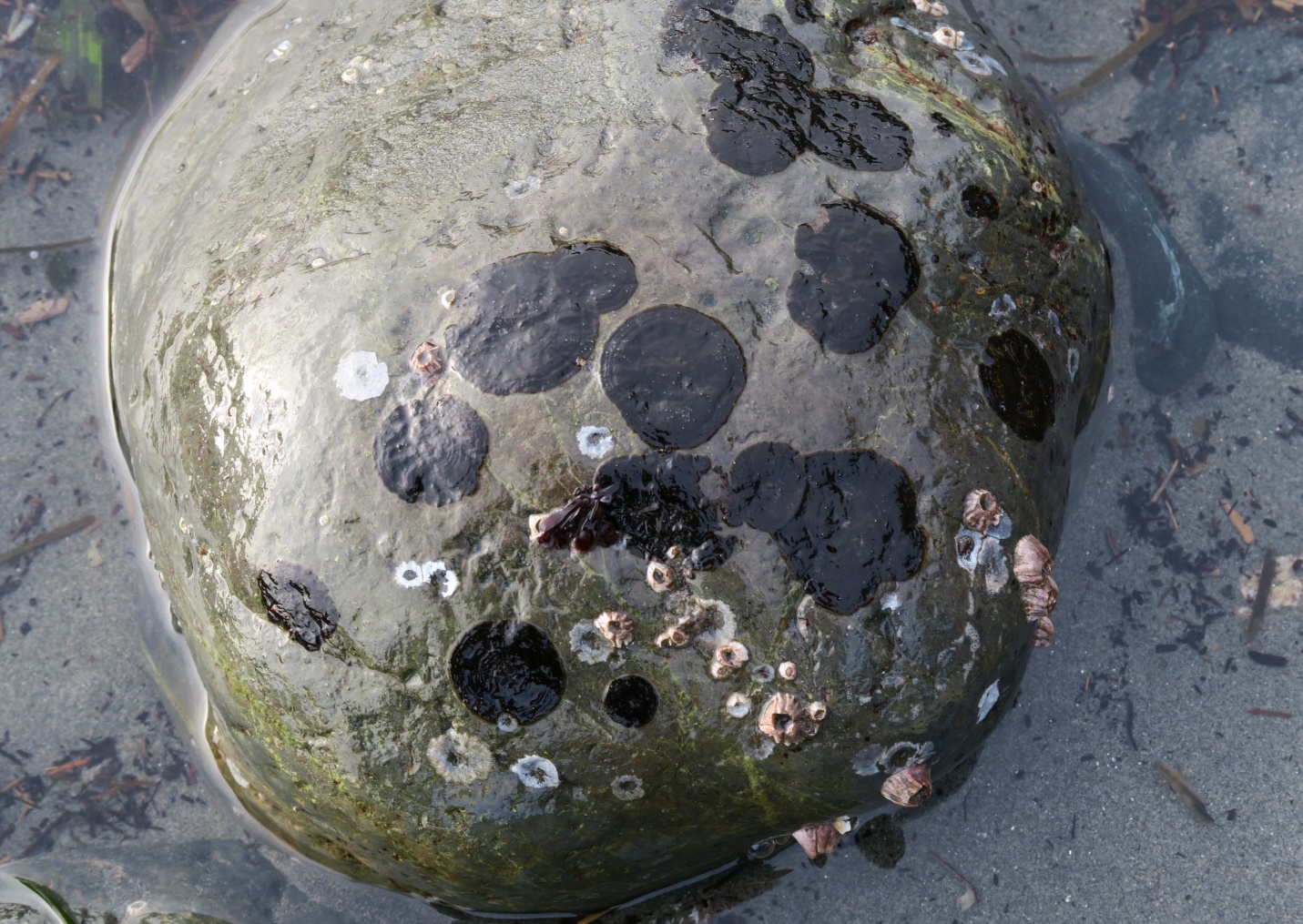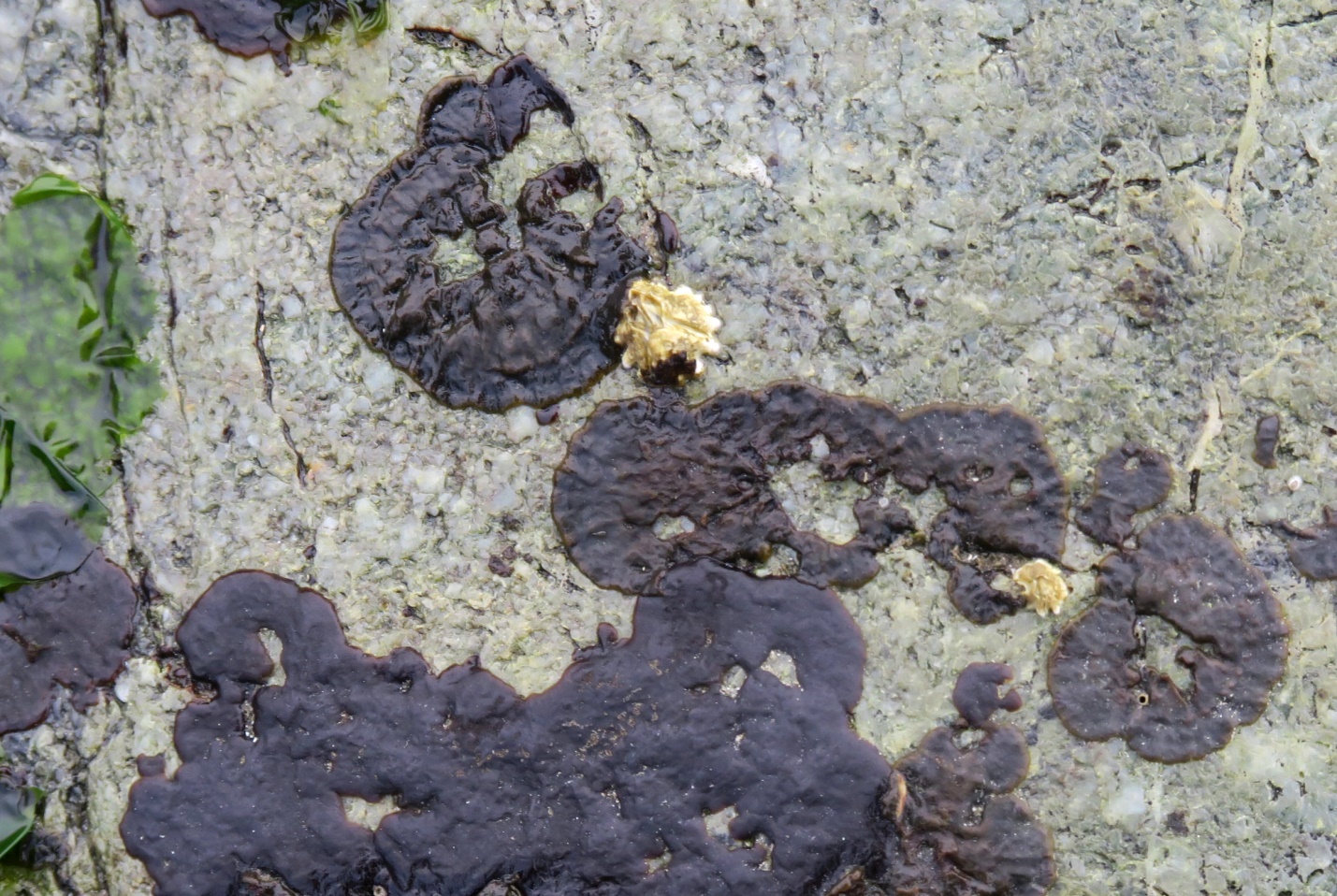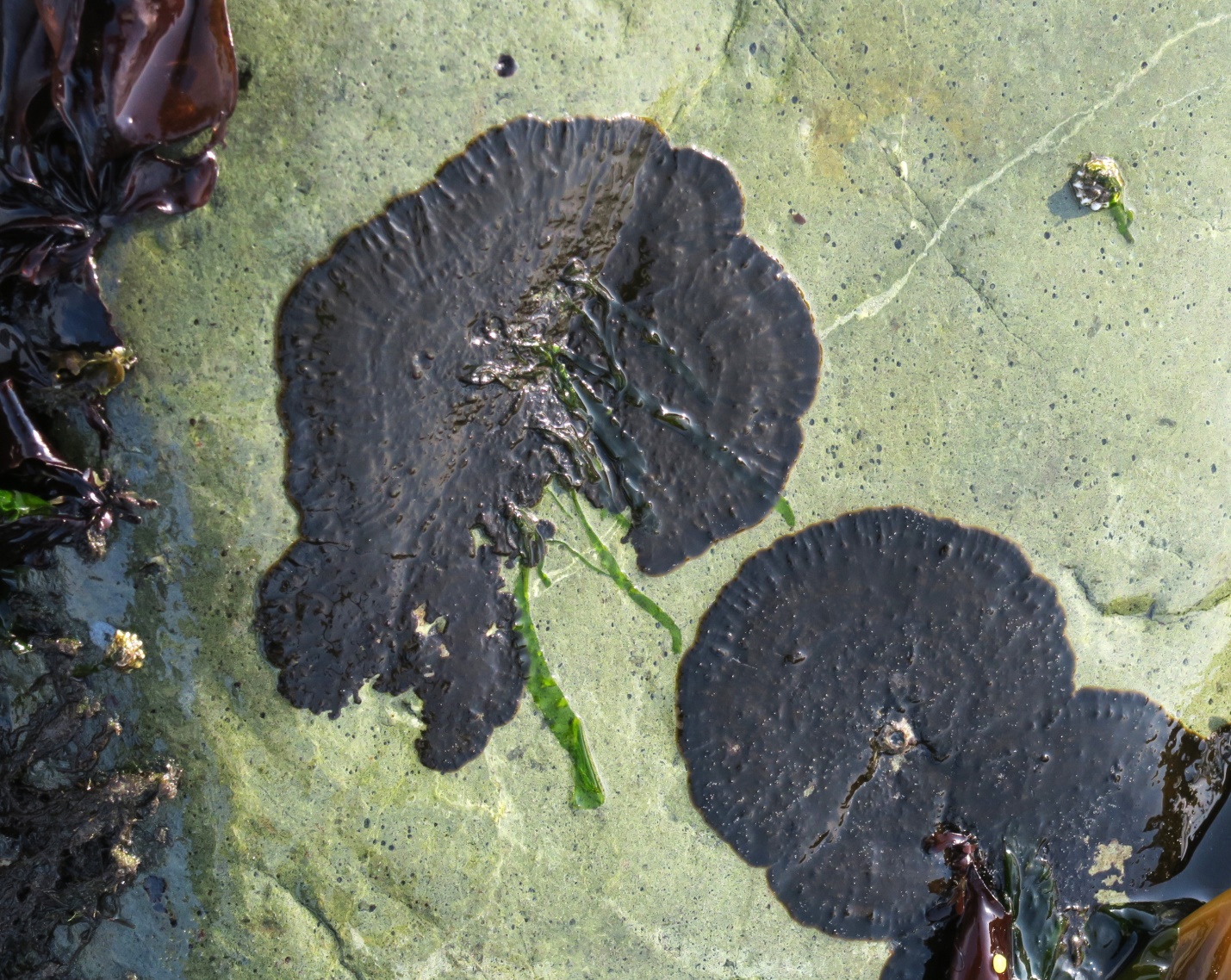
Ralfsia pacifica
Pacific Ralfsia
French Beach, Juan de Fuca Strait, B.C., Canada
17 February 2023
Low tide 0.8 feet at 18:03 PST (measured at Sheringham Point Tidal Station)
Weather: Overcast, wind variable 10-15 km/hour, no precipitation, light chop, moderate southerly swell, temperature 7 ˚C, relative humidity 72%.
Phase of Moon: Waning Crescent, 9.0%, or 27 days past the new moon; (Previous Phase, Third Quarter, 13 Feb 2023 at 08:00am PST; Next Phase, New Moon, 19 Feb 2023 at 11:05pm PST.)

Figure 1: Boldly growing on the face of this low intertidal cobble, is Ralfsia pacifica. This individual had overgrown a barnacle ‘footprint’ and at this spot now has crumbled somewhat itself. The remainder of this crustose brown alga shows the characteristic concentric growth rings. French Beach, Juan de Fuca Strait, B.C., Canada. February 17, 2023. Photo ID 27557 ©Seaweedwhisperings.com
Person 1:
Rounded, no sharp edges.
Tough on the outside, but brittle inside. I saw a cluster of Ralfsia that had only the outer circles remaining, with the centers all weathered out.
Seems to prefer smooth, rounded boulders where it dominates. Very few other organisms can attach / cling to such a substrate.
Sometimes weathers into a trilobite-shaped form. Is it ancient? Weathered? Clinging to the past? Fossilized?
Bumpy and rounded and shiny in its prime. When at its prime it’s impervious.
In its element it happily endures the force of crashing surf.
Concentric circles... rings / layers of protection?
Prime? I need to reflect more? Struggling to maintain prime?
Competition? Not a good fighter. Thrives where it doesn’t need to compete.
My insides (intestines) are gurgling a lot over the past ten minutes; is this related to his Whispering?

Figure 2: Pulling back to give a fuller view, several Ralfsia seaweeds are shown populating this one large cobble in the low intertidal zone of a wave exposed beach. French Beach, Juan de Fuca Strait, B.C., Canada. February 17, 2023. Photo ID 27558 ©Seaweedwhisperings.com
Person 2:
Finally! A fairly low tide occurring in daylight hours at French Beach; we’ve been waiting for this opportunity. As I walked out to explore the rough beach of modest sized cobbles here, one of the first seaweeds I noted was Ralfsia pacifica.
Sets of these flat, rounded, dark brown crusts seem to find the smoothed surfaces of the cobbles here to be an ideal habitat.
Today many Ralfsia are exposed above the retreating tide. Still glossed with sea water, they look stable, calm, in control. There’s no sense of concern; they are in the right place and doing a fine job.
It strikes me that many of the times I’ve seen Ralfsia it has been in places that were quite difficult for humans (me) to remain in very long, or even for that matter, difficult for me to get close to them.
It seems to me that Ralfsia picks places to live that are stark locations – such as right at the protruding curve of a cobble or boulder and not in the densely populated mix of the “algal metropolis”. Like a ships bow, Ralfsia seems like it is designed to, and perhaps wants to, face the elements first and “head on”. And like barnacles on a whale’s skin or a ship’s hull, it seems that Ralfsia will persist forever in these utterly exposed places.
Tough.
Adhered, as if one, with the rock.
I can’t scrape off any part of you, except maybe only a tiny bit of the leading edge if I use a strong edged tool. But otherwise you are secure in your place and will not be moved from it.
And your form of growth, it is as an ever-expanding circle. I can see rings from your previous years’ expanse.
It’s vaguely like seeing / counting growth rings of a tree from a cross section of its trunk.
And like a tree, Ralfsia, your most “living” or “active” areas seem to be the outer rings of your mass. Here is where there is current activity. And in the more central regions of you, it seems like this area is somewhat forgotten or set aside as past history or perhaps is an enduring relic.
Maybe you don’t have enough vitality to keep all of yourself active, so you prioritize your leading edges, the ring of growth at your perimeter.
The perimeter is also where two planes of you are exposed and interacting with the world, your height and your breadth. The central part of you has only one plane left open to interact and possibly this is why it seems rather stoic or even lifeless.
So..., if your outer ring is where the action is, I still see that the “action” is quite subdued, slow and measured. One would not capture any dynamic Ralfsia qualities by making a video of this seaweed as compares to other species such as Lessoniopsis littoralis, for example. And I don’t think you hardly ever present with anything much surprising or out of character, Ralfsia. Your “face” is flattened and reveals no change of expression, even when hit by a hard blow (a pounding wave or debris floating in the surf).
I think this is related to your need to be tough.
Your look is almost that of a bull’s eye target. A round target with concentric and radial markings.
Do you take the aggression that comes at you in stride? I think you do.
Maybe even you have a purpose in that, Ralfsia. Your role can be to “be” the “target”, since you can do this and suffer little harm. This then frees others from the attention of the aggressors. You would be valued in a community for this quality.
The middle of your circle could be construed as the center of the target, the focus, but since where you truly “live” is in your outer rings, you perhaps cleverly elude or evade harm. Others who only “aim” traditionally at “center mass” would not know that by doing so they are missing your most vulnerable regions.
And with your active and most dynamic part being at your perimeter, in those rings, what does that mean for you, Ralfsia?
Is your flow or awareness rather circular?
Do things get “stuck” in you – going ever and only around and around in circles?
Or do you have an interesting “data translation” ability that can understand the world viewed from 360 degrees?
And there is, of course, that one plane, your flat broad face, that one dimension that possibly connects it all for you? Connects it all, but only for your internal, personal knowledge?
Your face, it looks so fixed that it is almost fossilized. Is there a record, written there slowly over time that is permanent and enduring?
I think Ralfsia that you maybe are not just the records themselves, but somehow you’re involved in setting the record straight, in showing it to the world, in a calm and unhurried manner.
You have no desire to “prove” anything, but I think that you do care to “represent” something and to represent it well.
Fossil..., slow..., calm..., unhurried..., represent well – I merged those concepts with a couple of circumstances that occurred while making our Whispering record. First was the long series of ambulance / police / fire sirens we heard and, second, was that I sneezed, suddenly and rather loudly, and this noise “alarmed” Person 1, startled him due to its unexpected nature.
It made me ponder a bit and I think that Ralfsia would be strong in the face of urgent matters or emergency situations. They may not have the personal skills entirely on their own to meet and handle the emergency, but they do have the experience, long experience actually, that tells them this, too, will be worked out. That the story, indeed history, will go on.
Ralfsia is a flat crust. Flat can reflect characteristics such as dull, boring and tedious; this is a rather different side of the calm, even and smooth-in-the-face-of-emergencies traits. Perhaps this serves Ralfsia, too. When I noted this as one of the first seaweeds I spotted on my beach explorations on the day of our Whispering, I also realized that many people might not even think this was a seaweed and surely might not consider it to be an interesting find! Compared to some of the intricately patterned reds or the bright and lively greens and even compared to many other browns that have dramatic blades and mid ribs and air bladders and wings that dance in the ocean swells, well, Ralfsia, you could superficially seem far less interesting and boring, indeed.
Certainly this could divert attention away from you and possibly you find that useful to your purposes. After all, there are enough times when you are the “target” that is standing in the line of attack or criticism, so being overlooked at other times is a break you can be grateful for.

Figure 3: In this photograph there are two crust algae living side by side, the smother one, that looks like melted dark wax or tar, is the red algal crustose phase of Mastocarpus spp. The bumpier “rings” of crusts that show yellowish-brownish edges and hints of concentric growth circles, these are Ralfsia pacifica – a brown alga belonging to a totally different taxonomic kingdom. Gonzales Bay, Juan de Fuca Strait, B.C., Canada. August 23, 2021. Photo ID 27559 ©Seaweedwhisperings.com
Discussion:
If you’re out in the open like Ralfsia, you are an exposed “target”. And so the Ralfsia energy is by its very nature competent at handling that situation. This may be why they have to struggle to maintain their prime, and that they work hard to keep their place and their face wide open for all to see.
What then takes second place to this role of being the impervious target? Is it the ability to relax with exploration and to be themselves? This is very much like the alga itself; it is a hard crust, and just like the coralline crusts, it seems necessary to have an armor-like or hardened quality. They MUST have this quality, in fact, in order to survive and thrive where they live and for the purposes they undertake.
And we noted one refinement to an earlier thought. Is Ralfsia’s interior truly brittle or is it brittle due to disuse? It seemed to us that this energy often chooses, in the challenges of life, to pour energy to their periphery and by doing so they may neglect to nourish their interior. There seems to be a focus on strength through hardness, as opposed to strength through flexibility. Perhaps, too, this hardness is the net result of something long-lived and even fossilized-looking – parts become static; they can look well-armored and impervious but they might in fact crumble or shatter due to brittle hardness. Then is the outer ring enough? Does the perimeter endure in a meaningful way...?

Figure 4: These Ralfsia reveal their “age” as they have been in existence long enough that other macro algae (in this case both red and green) have made their home anchored to the Ralfsia crusts themselves. The radial and concentric patterning notable for Ralfsia can be seen on these individuals. French Beach, Juan de Fuca Strait, B.C., Canada. August 21, 2021. Photo ID 27560 ©Seaweedwhisperings.com
Biology & Natural History Information:
Description:
The thallus of this slow growing perennial brown alga forms a flat encrusting layer, firmly adhered to the substrate. The crust is smoothish, looks somewhat thick forms nearly circular patches. At the margins it can be lobed, but even at these edges it is strongly affixed to the substrate. Another brown crust alga and near relative, Ralfsia fungiformis, differs in that it has a strongly lobing pattern and the crust margins are free of the substrate and are prominently overlapping - much like land-based organism Tramates versicolor (Turkey tail mushroom). Ralfisa pacfica grows from 2 to 12 cm in diameter and is from .5 to 1.0 mm thick. It is olive brown to black in color and the surface is often patterned with radial or concentric rings.
Habitat:
Ralfsia pacifica is a prominent crust in the mid to low intertidal regions. It grows on rocks and sometimes on shells of wave exposed or semi-exposed habitats.
Pacific Coast Distribution:
From Alaska to Mexico.
Remarks:
Ralfsia pacifica can be distinguished from other Ralfsia species by its firmly adhered margins, and also by the fact that you will not find it growing in tide pools; R. californica prefers the tide pool life and R. fungiformis will also sometimes inhabit tide pools.
The genus name, Ralfsia, is for John Ralphs, a British phycologist. Ralphs published in 1848 his work “The British Desmidieæ.” Desmidiales or ‘desmids’ are mainly fresh water species that are an order in the Charophyta, a division of microscopic green algae from which land plants (Embryophyta) emerged.
Classification:
Phylum: Ochrophyta
Class: Phaeophyceae
Order: Ralfsiales
Family: Ralfsiaceae
Genus: Ralfsia
Species: Ralfsia pacifica Hollenberg 1944
Former name(s): Ralfsia occidentalis Hollenberg 1945

Figure 5: This Ralfsia individual shows more of the radial lines than concentric and it is a clear example of at least three algal crustose species growing on this boulder. The pink crust is sprouting its foliose form – a wingnut articulated alga which is the pink skeletal looking seaweed on the left. The large circular brown crust, however, our Whispering subject Ralfsia pacifica, has only the crustose form in its life cycle. The third crusts are the much smaller smooth brown patches seen on this boulder; they are small, can be individual and circular or confluent and larger. One that is identifiable in this photo is on the rim of the pink coralline crust in the lower right hand section of the photo. Growing from this crust are two tiny blades of Petalonia fascia. The crust is believed to be the alternate sporophytic phase or the basal system of this seaweed species. French Beach, Juan de Fuca Strait, B.C., Canada. February 17, 2023. Photo ID 27561 ©Seaweedwhisperings.com
![]()